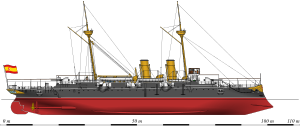Spanish cruiser Alfonso XIII facts for kids
 |
|
Quick facts for kids History |
|
|---|---|
| Name | Alfonso XIII |
| Namesake | King Alfonso XIII of Spain |
| Builder | Naval shipyard at Ferrol, Spain |
| Cost | 9,000,000 pesetas |
| Laid down | 1891 |
| Launched | 31 August 1891 |
| Completed | nominally (as training ship) 1896; fully completed 18 May 1900 |
| Commissioned | 18 May 1900 |
| Fate | Scrapped in early 1900s |
| General characteristics | |
| Class and type | Reina Regente-class protected cruiser |
| Displacement | 4,725 tons |
| Length | 317 ft 0 in (96.62 m) |
| Beam | 50 ft 0 in (15.24 m) |
| Draft | 20 ft 4 in (6.20 m) mean |
| Installed power | Rated at 11,500 ihp (8,600 kW) (forced draft); actual power much less |
| Propulsion | 2-shaft, horizontal triple expansion |
| Speed |
|
| Endurance | Coal 1,200 to 1,285 tons (normal) |
| Complement | 440 officers and enlisted |
| Armament |
|
| Armor |
|
Alfonso XIII was a Reina Regente-class first-class protected cruiser of the Spanish Navy which served in the Spanish fleet from 1896 until the early years of the 20th century.
Technical characteristics
Alfonso XIII was built at the naval shipyard at Ferrol in Spain. Laid down in 1891, she was launched on 31 August 1891. In 1896, she entered service in a partially completed state as a training ship. She finally was fully completed and commissioned on 18 May 1900.
The ships of the class were intended to have heavy armament and high speed on a small displacement. The lead ship, Reina Regente, although otherwise considered excellent, had proven top-heavy, so changes were made to Alfonso XIII to address this, including a smaller main gun. However, the changes, intended to improve upon Reina Regente, instead left Alfonso XIII lightly armed, slow, and still unstable in heavy seas.
The Hontoria-built 7.9-inch (201 mm) guns were in single mounts on the broadside fore and aft, while the 4.7-inch (119 mm) guns were in a central battery amidships. All five torpedo tubes were fixed and above the waterline, with two forward, one on each broadside, and one aft.
Operational history
Alfonso XIII was not yet fully complete when she entered service as a training ship in 1896. Still incomplete at the time of the Spanish–American War, she was sent to Cadiz on 7 May 1898 to join the Spanish Navy's 2nd Squadron, under the command of Rear Admiral Manuel de Camara, then forming for a voyage to the Philippines. Due to her incomplete condition, Camara decided to leave her behind at Cadiz when his squadron departed on 16 June 1898 on its abortive voyage. Alfonso XIII spent the rest of the war in Spanish waters to defend Spain's coast from a potential attack by the United States Navy.
After the war, Alfonso XIII finally was completed on 18 May 1900, and she was commissioned the same day. Her shortcomings in seaworthiness led her to having a short career, and she was soon stricken and scrapped.
See also
 In Spanish: Alfonso XIII (1896) para niños
In Spanish: Alfonso XIII (1896) para niños


